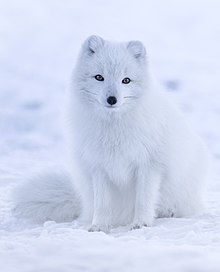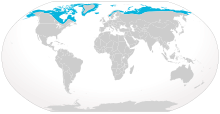
Back Poolvos Afrikaans Vulpes lagopus AN ثعلب قطبي Arabic ثعلب قطبى ARZ Vulpes lagopus AST Bresol (Vulpes lagopus) AVK Qütb tülküsü Azerbaijani قۆطب تۆلکوسو AZB Аҡ төлкө Bashkir Пясец Byelorussian
| Arctic fox | |
|---|---|

| |
| Scientific classification | |
| Domain: | Eukaryota |
| Kingdom: | Animalia |
| Phylum: | Chordata |
| Class: | Mammalia |
| Order: | Carnivora |
| Family: | Canidae |
| Genus: | Vulpes |
| Species: | V. lagopus
|
| Binomial name | |
| Vulpes lagopus | |

| |
| Arctic fox range | |
| Synonyms[4][5][6][7] | |
| |
The Arctic fox (Vulpes lagopus), also known as the white fox, polar fox, or snow fox, is a small species of fox native to the Arctic regions of the Northern Hemisphere and common throughout the Arctic tundra biome.[1][8][9][10] It is well adapted to living in cold environments, and is best known for its thick, warm fur that is also used as camouflage. It has a large and very fluffy tail. In the wild, most individuals do not live past their first year but some exceptional ones survive up to 11 years.[11] Its body length ranges from 46 to 68 cm (18 to 27 in), with a generally rounded body shape to minimize the escape of body heat.
The Arctic fox preys on many small creatures such as lemmings, voles, ringed seal pups, fish, waterfowl, and seabirds. It also eats carrion, berries, seaweed, and insects and other small invertebrates. Arctic foxes form monogamous pairs during the breeding season and they stay together to raise their young in complex underground dens. Occasionally, other family members may assist in raising their young. Natural predators of the Arctic fox are golden eagles,[12] Arctic wolves, polar bears,[13] wolverines, red foxes, and grizzly bears.[14][15]
- ^ a b Angerbjörn, A. & Tannerfeldt, M. (2014). "Vulpes lagopus". IUCN Red List of Threatened Species. 2014: e.T899A57549321. doi:10.2305/IUCN.UK.2014-2.RLTS.T899A57549321.en. Retrieved 19 November 2021.
- ^ "Vulpes lagopus". NatureServe Explorer. Retrieved 17 April 2024.
- ^ Linnæus, C. (1758). "Vulpes lagopus". Systema naturæ per regna tria naturæ, secundum classes, ordines, genera, species, cum characteribus, differentiis, synonymis, locis. Tomus I (in Latin) (10th ed.). Holmiæ (Stockholm): Laurentius Salvius. p. 40. Archived from the original on 8 November 2012. Retrieved 23 November 2012.
- ^ Oken, L. (1816). Lehrbuch der Naturgeschichte. Vol. 3. Jena, Germany: August Schmid und Comp. p. 1033.
- ^ Merriam, C.H. (1900). "Papers from the Harriman Alaska Expedition. I. Descriptions of twenty-six new mammals from Alaska and British North America". Proceedings of the Washington Academy of Sciences. 2: 15–16. JSTOR 24525852. Archived from the original on 4 March 2018.
- ^ Merriam, C.H. (1902). "Four New Arctic Foxes". Proceedings of the Biological Society of Washington. 15: 171. Archived from the original on 4 March 2018.
- ^ Merriam 1902, pp. 171–172.
- ^ Wozencraft, W. C. (2005). "Order Carnivora". In Wilson, D. E.; Reeder, D. M. (eds.). Mammal Species of the World: A Taxonomic and Geographic Reference (3rd ed.). Johns Hopkins University Press. pp. 532–628. ISBN 978-0-8018-8221-0. OCLC 62265494.
- ^ "Arctic Fox | National Geographic". Animals. 10 September 2010. Archived from the original on 5 November 2016. Retrieved 28 January 2019.
- ^ "Arctic fox | mammal | Britannica". www.britannica.com. Retrieved 8 April 2023.
- ^ Cite error: The named reference
dx.doi.orgwas invoked but never defined (see the help page). - ^ Arctic Fox at Fisheries and Land Resources
- ^ Arctic Fox at National Geographic
- ^ Gallant, D.; Reid, D.G.; Slough, B.G.; Berteaux, D. (2014). "Natal den selection by sympatric arctic and red foxes on Herschel Island, Yukon, Canada". Polar Biology. 37 (3): 333–345. Bibcode:2014PoBio..37..333G. doi:10.1007/s00300-013-1434-1. S2CID 18744412.
- ^ Noren, K.; Hersteinsson, P.; Samelius, G.; Eide, N.E.; Fuglei, E.; Elmhagen, B.; Dalén, L.; Meijer, T. & Angerbjörn, A. (2012). "From monogamy to complexity: social organization of arctic foxes (Vulpes lagopus) in contrasting ecosystems". Canadian Journal of Zoology. 90 (9): 1102–1116. doi:10.1139/z2012-077.
© MMXXIII Rich X Search. We shall prevail. All rights reserved. Rich X Search

